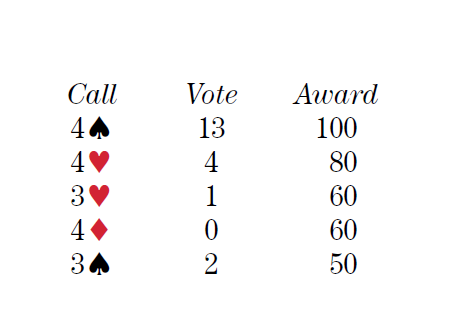
What’s your call?
| 3♥ | 3♠ | 3NT | ||
| 4♣ | 4♦ | 4♥ | 4♠ | 4NT |
| 5♣ | 5♦ | 5♥ | 5♠ | 5NT |
| 6♣ | 6♦ | 6♥ | 6♠ | 6NT |
| 7♣ | 7♦ | 7♥ | 7♠ | 7NT |
| Dbl | Pass |
Putting it together
4♠ is the top vote getter.
“Extras in context compel me to bid game,” says Rigal. “3♥ might be played as ‘last train,’ but why mess around when (at least until I see dummy) I think I know where I want to play? Partner rates to have a heart stack, but 3NT isn’t in the picture.”
4♠ from Hampson: “This hand appears to fit nicely, but I don’t want to overstate my strength or divulge which lead to make.”
The Joyces: “Because we have a lot of offense for a 9-point hand, we can’t resist accepting partner’s invitation.”
The Coopers feel unsure about partner’s 3♦ . “In our partnership, it is a four-card limit raise, 2♥ is a three-card limit raise and 3♥ is a mixed raise. Whatever it is here, we are 6–4 with aces, so we bid 4♠.”
Weinstein’s reasoning: “Even though 3♦ is a stronger spade raise than 2♥ (and should show four trumps), it’s pretty hard to construct a hand where we are making a slam after partner didn’t splinter.”
Colchamiro’s logic for bidding the spade game is similar: “Isn’t 3♦ the stronger cuebid vis-a-vis 2♥ ? If partner has only three trumps, he’s got a bunch of extras.”
Sanborn agrees. “3♦ should be a stronger cuebid than 2♥. We can pretty much play partner for a good hand with five or more hearts and at least three spades, so the probable shortness in diamonds looks good facing this hand.”
“4♠,” declares Meckstroth. “Good fit and good shape should make this a good spot.”
The Gordons bid 4♠. “If partner’s hand is good enough to be slammish, he must have wasted values in hearts, so no splinter/cuebid.”
Cohen bids 4♠, but gives some thought to the slam he’s giving up on. “Voids are magical. There is no way to stop on a dime in a partscore when even six might make opposite:
♠K x x x ♥ J x x x x ♦ x ♣A Q x.
Looking at my construction (and partner could have even more) makes me think that maybe I am worth more than 4♠, like a control bid!”
Robinson proposes 4♥, a splinter in support of spades. “Partner could have:
♠K Q x ♥ x x x x ♦ K x ♣A Q x x
and we might make seven.”
Lawrence envisions slam. “4♥ — a splinter. A modest slam try. If they bid again, partner will have a clue as to my hand.”
Walker also uses 4♥ to issue a slam invitation. “Partner is probably short in diamonds, which means he’d rather hear about the heart control than the ♦A. My jump shows shortness (I think it should suggest a void on this auction) and lots of enthusiasm for slam.”
On the more pessimistic end of the spectrum, the Sutherlins merely invite game with 3♥. “Partner has an opening bid with three or four spades and a stiff diamond. Let’s ask partner to focus on his club holding.”
Meyers is willing to give up on game entirely. “3♠. It is matchpoints. I need North to have a lot to cover my losers and I think she has heart cards, which won’t help me.”

